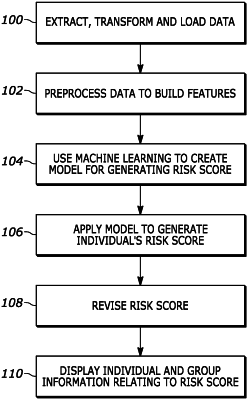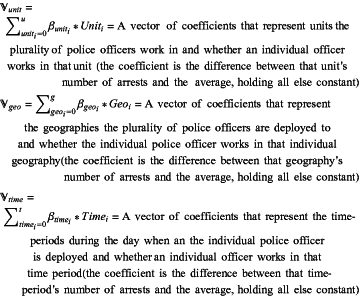| CPC G06Q 10/0635 (2013.01) [G06N 20/00 (2019.01); G06Q 10/06398 (2013.01); G06Q 10/063114 (2013.01); G06Q 50/26 (2013.01)] | 15 Claims |

|
1. A machine-learning based system configured to generate a risk score that predicts whether an officer is at risk of involvement in an adverse event, comprising:
a preprocessing module for collecting and storing historical data about a plurality of characteristics and events relating to a plurality of police officers and creating and storing a first-level residual feature ε=representing the number of arrests that the officer has more or less than the average that the officer's department holding all other variables constant, based on the historical data as follows:
Y=β0+
 unit+ unit+ geo+ geo+ time+ε time+εwhere:
Y=the number of arrests that have occurred in a certain time period for the officer
β0=the average number of arrests for the officer's department
 ε=the officer's residual=The number of arrests that the individual officer has more or less than the average, holding all other variables constant;
a machine learning module for accessing the stored first-level residual feature and: (a) constructing and storing a plurality of models that predict the risk of an adverse event and generating a risk score, each of the models including the first-level residual feature, (b) running each of the models, with the machine learning module, using the collected, historical data, (c) identifying which one of the plurality of models would have best predicted an adverse event in the past and (d) saving the identified model for use by the system to predict an adverse incident in the future; and,
a model application module for running the identified model using data about the officer and generating: (a) a risk score for the officer and (b) other information relating to the risk score, and for outputting the risk score and the other information relating to the risk score from the model application module to a display for displaying the risk score and information relating to the officer's risk score.
|